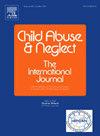从寄养到监禁:对国家过渡青年数据库的前瞻性分析
IF 3.4
2区 心理学
Q1 FAMILY STUDIES
引用次数: 0
摘要
寄养儿童在成年后往往面临巨大的逆境,包括被监禁的风险增加。然而,成人监禁率在成年后离开寄养的青少年、与家人团聚的青少年以及被收养或由法定监护人安置的青少年之间是否存在差异尚不确定。目的:本前瞻性研究调查了17岁青少年成人监禁的发生率,并考察了监禁的风险是否因寄养机构的退出类型而有所不同,无论是总体上还是在不同的种族/民族群体中。参与者和环境样本包括24,573名寄养青年,他们在17岁、19岁和21岁生日后不久参加了全国转型青年结果调查。方法采用流行率报告和logistic回归分析。回归模型包括相互作用项,以评估种族/民族是否调节寄养退出类型对成人监禁的影响。结果超过30%的青少年在17岁之前被监禁,近30%的青少年在17至20岁之间被监禁。与失去照顾的青少年相比,团聚的青少年被监禁的风险更高,而被收养或被监护的青少年被监禁的风险较低。与白人男性相比,黑人男性面临更高的入狱风险,而西班牙裔女性被监禁的可能性低于白人女性。主要种族/民族类别没有显著调节退出类型的影响。结论尽管人们对无照料青年的老龄化问题给予了相当大的关注,但本研究强调需要更多地关注与家人团聚的青年的福祉。本文章由计算机程序翻译,如有差异,请以英文原文为准。
From foster care to incarceration: A prospective analysis of the National Youth in Transition Database
Background
Children in foster care often face significant adversity in adulthood, including a heightened risk of incarceration. Yet, it is uncertain whether adult incarceration rates differ between youth who age out of foster care, youth who are reunified with their families, and those adopted or placed with a legal guardian.
Objective
This prospective study investigates the prevalence of adult incarceration for youth in care at age 17 and examines whether the risk of incarceration varies by foster care exit type, both overall and among different racial/ethnic groups.
Participants and settings
The sample consists of 24,573 youth in foster care who participated in the National Youth in Transition Outcome Survey shortly after their 17th, 19th, and 21st birthdays.
Methods
The study utilizes prevalence reporting and logistic regression analyses. Regression models include interaction terms to assess whether race/ethnicity moderates the impact of foster care exit type on adult incarceration.
Results
Over 30 % of youth reported incarceration by age 17, and nearly 30 % experienced incarceration between 17 and 20. Compared to youth who aged out of care, youth who reunified had a higher risk of incarceration while youth who were adopted or placed in guardianship had a lower risk. Compared to White males, Black males faced a higher risk of incarceration, while Hispanic females were less likely than White females to be incarcerated. Primary race/ethnicity categories did not significantly moderate the effect of exit type.
Conclusions
Although considerable attention has been given to youth aging out of care, this study highlights the need for greater attention to the well-being of youth who reunify with their families.
求助全文
通过发布文献求助,成功后即可免费获取论文全文。
去求助
来源期刊

Child Abuse & Neglect
Multiple-
CiteScore
7.40
自引率
10.40%
发文量
397
期刊介绍:
Official Publication of the International Society for Prevention of Child Abuse and Neglect. Child Abuse & Neglect The International Journal, provides an international, multidisciplinary forum on all aspects of child abuse and neglect, with special emphasis on prevention and treatment; the scope extends further to all those aspects of life which either favor or hinder child development. While contributions will primarily be from the fields of psychology, psychiatry, social work, medicine, nursing, law enforcement, legislature, education, and anthropology, the Journal encourages the concerned lay individual and child-oriented advocate organizations to contribute.
 求助内容:
求助内容: 应助结果提醒方式:
应助结果提醒方式:


